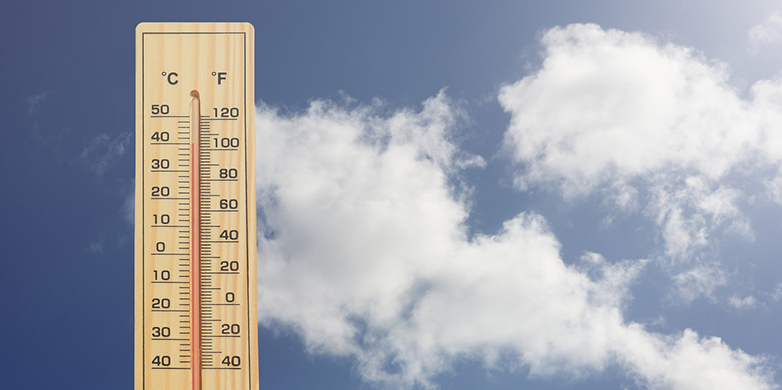What's left of the warming pause
After two years of record-breaking temperatures, the global warming pause – and public interest along with it – has melted away. Scientists’ failure to engage with the media led to a fierce public debate about the end of climate change that now appears to have been a storm in a teacup.

The “hiatus” was born in the blogosphere. The term loosely refers to a multi-year period starting in the record-warm year 1998, in which global temperatures had seemingly not warmed. Initially the period was short, and not unexpected to scientists. However, as climate change sceptics highlighted the phenomenon on their blogs, it began to receive increasing interest from the mainstream media.
With every year that did not set a new warm record, scientific interest also increased because the public demanded answers, and as the warming pause persisted it became less likely that it could be explained by natural variations alone.
A simple question of definition
After nearly 200 peer-reviewed publications and several years of scientific debate, scientists do not even agree whether the hiatus ever existed. Some find support for it, while others do not. In a review published in Nature [1], we look at all the evidence and research about the hiatus and conclude that it all comes down to the definition. Seemingly contradictory conclusions result from scientists using the same term but with different definitions, different datasets, and slightly different time periods.
But, the most important question remains: do the observed temperatures since 1998 differ so fundamentally from models that they call into question our scientific understanding of anthropogenic climate change?
In fact they do not – when we prescribe the observed solar activity and atmospheric concentration of particles from volcanic eruptions and account for the observed variations of the Pacific Ocean temperatures, models and observations are consistent. In observations, we have to further account for areas of missing data in the global coverage, for example in the rapidly warming Arctic. Then, the observations agree remarkably well with the model average.
History of solving a mystery
The most interesting thing, however, is probably the discussion that followed within a social context. Scientists had apparently been too focused on communicating the long-term warming trend and thereby neglected to highlight the fact that simple natural variations could lead to such a phenomenon. The considerable pressure from outside the scientific community sparked many interesting research projects, but science takes time, and it took several years to provide a complete explanation.
The media and the public are often asking for quick explanations, which scientists struggle to provide. Establishing an understanding of natural phenomena requires time – for good reason – time to make hypotheses, to test them rigorously, to publish results and to challenge others in order to reach conclusions on the scientific findings. Sometimes it is better to say “we don’t know yet” than to rush to conclusions. Scientists must learn to engage with the public even when evidence is still accumulating and robust conclusions cannot yet be made.
Now that the explanations are on the table, public interest has disappeared. Whether or not it happened depends on the definition.
We do not observe global temperature
To further understand what happened, it is important to realise we do not measure the global temperature, but local temperature at lots of locations around the world: making a global temperature dataset is not easy. To be able to say whether the Earth warmed or not during the hiatus, we need to know the limitations of the observations, like in the regions where there are few or no measurements. This is particularly important for changes in temperature over the course of up to a decade or so.
Not all temperature measurements are made in the same way, and the difficulties start when putting them together. For example, the way sea temperature is measured has slowly changed over the time, and can introduce an artificial trend in the global temperature; this must be accounted for. As more research goes into how to combine the different measurements, temperature records are adapted for this. This leads to small adjustments in both the historical and the recent parts of the global temperature records as we acquire more knowledge.
Given these challenges, it is crucial to note that five comprehensive global temperature estimates have been made by independent institutions that differ considerably in the methodologies used, and thus in the exact temperature from year to year. Nevertheless, all of them agree on the long-term warming trend and none show a zero trend of more than 12 years during the hiatus period.
Preventing further storms in teacups
Given the declining evidence for a period of “no warming”, the hiatus definition changed to a period of “warming significantly less than before” or “less than the models say”. Today, there is little remaining scientific evidence for even these anymore.
Nevertheless, it is important to note that the observations still only give a limited view of what the real world does, and the models give another view. This is why we need the strengths of both models and observations, so that we can minimize the effect of the unknown and avoid making a non-issue into the next big thing.
Iselin Medhaug wrote this text together with Erich Fischer.
Further information
[1] I. Medhaug, M. B. Stolpe, E. M. Fischer, R. Knutti (2017): external pageReconciling controversies about the global warming hiatuscall_made. Nature, doi: 10.1038/nature22315
Previous articles on the hiatus:
Wie messen wir die Erderwärmung? (Zukunftsblog, 23.06.2015)
Hat die Klimaerwärmung nur scheinbar pausiert? (Zukunftsblog, 18.06.2015)
Why global warming is taking a break (ETH-News, 18.08.2014)

